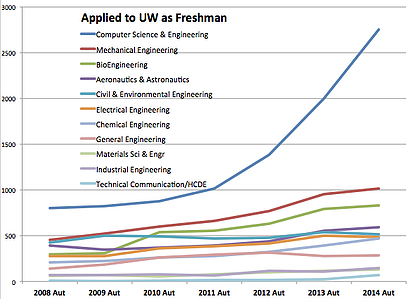Summer slide achievement gap vacation
This shouldn't come as a surprise, but after three months off in the summer most kids return in September at a lower learning level than when they departed: A whole month behind, according to Catherine Augustine a senior policy researcher at the RAND Corporation who has studied summer learning loss. Apparently a majority of children come back behind in math, whereas fewer are left behind in reading. This step backward is most obvious with children in low income neighborhoods where they might have less access to libraries and books in the home.
Over the years educators have promoted various changes in the educational system they thought might go a long way toward cutting back this deficit. School year-round was one idea; a marginally longer school year was another. The year-round idea apparently wasn’t anywhere near as effective as its proponents had hoped: studies still showed a deficit of one month or so at the beginning of the next year. It didn’t make much sense fiscally, and it surely ruined a lot of family summer vacations. Extending the school year made better financial sense but didn’t work all that well in some countries that had tried it, and Canadian schools showed better than the U.S. on the tests while only holding the kids in for three more days during the year.
- 0 Comments
- Jul 29, 2014 12:00:00 PM
- Posted by Charles Nimrad
- Topics: Education, 21st Century Classroom
Profesional Development Tips

When computers first burst into the classroom back in the late eighties and nineties, most teachers were nonplussed by a new technology they had hardly been aware of, much less trained for. They stared at these new machines and wondered what were they supposed to do with them. A lifetime of teaching couldn’t provide them with a clue and what they were hearing from their administrators only added to the confusion. As a result some retired rather than deal with the newfangled things and some simply set them on their desks and ignored them.
The majority, thankfully, buckled down and decided to find out how these things worked and how they could be made to serve their students. Of course one of the first things they discovered was that the students either already knew how to use the darn things or were capable of learning to use them faster than their teachers … and teachers are still playing catch up with their students with each new technological arrival.
- 0 Comments
- Jul 17, 2014 2:00:00 PM
- Posted by Charles Nimrad
- Topics: EdTech, Education, 21st Century Classroom
What Can We Do About Math Anxiety?

Parents, are you feeling guilty about inculcating your children with that educational scourge, Math Anxiety? Take heart, it might not be your fault. According to a recent study at Ohio State University, there is a genetic component to the malady. Says lead author Zhe Wang, “We found that math anxiety taps into genetic predispositions in two ways: people’s cognitive performance on math and their tendency toward anxiety..."
Which leaves us wondering, what can be done about math anxiety in teachers and students if math anxiety is genetic? I’m not a teacher and I haven’t been a math student for nearly half a century, but as a parent (Ok, Ok, a grandparent!) I’m relieved that yet another potential, parental guilt trip has been resolved in favor of nature rather than nurture.
- 0 Comments
- Jul 7, 2014 7:20:59 PM
- Posted by Charles Nimrad
- Topics: Math, Education, 21st Century Classroom
Chevron invests in bringing more girls into STEM
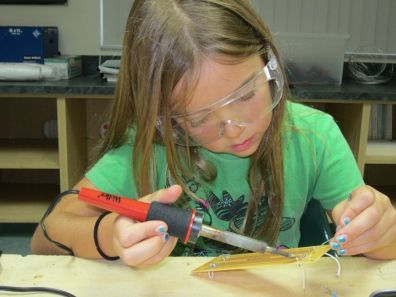
Some argue against the intrusion of big business into education. Critics left and right have what they consider good reason to fear the beginning of a “slippery slope” leading us toward disaster. President Obama seems to have no such fear as in his February 12, 2013 State of the Union Speech he asked for the creation of “manufacturing hubs, where businesses will partner with the Department of Defense and Energy to turn regions left behind by globalization into global centers of high-tech jobs.”
Energy giant Chevron is forging ahead with plans to assist educators of students who will become the tech sector's skilled STEM-educated employees. In the next three years Chevron intends to invest more than 30 million dollars in STEM learning in this country. Blair Blackwell, Chevron’s manager of education and corporate programs tries to alleviate the fear of big business intrusion by admitting that “We recognize we’re not education experts. We have to partner with the education experts, with officials on the ground.”
- 0 Comments
- Jun 19, 2014 12:00:00 PM
- Posted by Mike Nardine
- Topics: STEM, National News, Education, Education Politics, 21st Century Classroom
Can skateboarding help convince kids to like math?
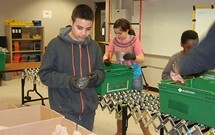
Teachers, are you having trouble convincing students in your STEM classes that the subject matter has relevance for their lives? Of course you are! What teacher isn’t? Luckily programs exist for this generation of hard-to-convince students that can help you. Among these is Rochester Institute of Technology’s REMS Program. Why? Well, it uses skateboards, for one thing. For those of you unfamiliar with the Rochester Institute of Technology (RIT), the school has been consistently rated 7th among regional colleges (North) by US News and World Report. It boasts that “Our outstanding faculty deliver innovative and creative programs that are enhanced by experiential education and world-class facilities.” The REMS program is proof of the truth behind that boast.
- 0 Comments
- Jun 18, 2014 12:30:00 PM
- Posted by Mike Nardine
- Topics: Education, 21st Century Classroom
The US needs more programs to expose students to computer science
The long and the short of it is simply this: the Bureau of Labor Statistics predicts that in the next six years the demand for computer programmers will exceed the supply by at least one million. That’s one million jobs that will likely go to individuals from outside the US. These will be some of the best paying jobs around and the segment of our society that will lose the most will be women, students from rural areas, and students of color.
Why is that? Colleges across the country are flooded with requests for an education in computer science in numbers that would meet that and any future demand. Simple answer: there are not enough classes, teachers or equipment to meet that enormous demand. And there's not much chance that will change anytime soon. Colleges and universities have simply been caught flat footed after cutting back in their computer science departments.
- 0 Comments
- Jun 16, 2014 6:56:26 PM
- Posted by Mike Nardine
- Topics: National News, Education, Education Politics, Computer Science
MakerBot Adds 3D Printable Curriculum Content to Thingiverse for Teachers
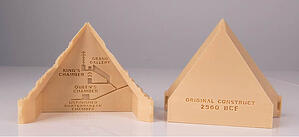
With our awards winning RobotsLAB Box (Gold Edison Award, Best STEM Solution by EdTech Digest, LAUNCHEDU COMPETITION AT SXSWEDU), we here at RobotsLAB are always on the lookout for innovative companies that compliment and enhance our product and further our view that STEM education need not be boring--or unaffordable. Makerbot, developer of the MakerBot Replicator Desktop 3D Printer is one such company.

Just as our robots engage students by demonstrating in real time the practical importance of math, MakerBot's 3D printers draw students in by showing them the fascinating new world of digital manufacturing. Engineering exercises like building bridges and pyramids, once cobbled together in the classroom with popsicle sticks, clay and epoxy, and taking days to build, can now be manufactured cleanly and swiftly in a matter of minutes or hours. Nor can the importance of students understanding the science and practice behind this new manufacturing method be overstated in terms of their future ability to access employment: no less a personage than President Obama has declared that 3D printing is the next manufacturing revolution and he intends that America will be the leader in this new revolution!
The first 3D printers, like the first computers, were huge and far more expensive than any school district could hope to put in the hands of its students. But Makerbot has brought the size down to little more than that of a desktop printer and the price to under $2000 dollars. Besides that, the company has made its printers available through crowdfunder Donorschoose.org; all teachers have to do is contact Donorschoose with their request. As of this writing more than a thousand schools have received printers.
- 0 Comments
- Jun 2, 2014 12:00:00 PM
- Posted by Elad Inbar
- Topics: EdTech, Education, 21st Century Classroom, Project Based Learning
Math curriculum makeover

Math teacher Dan Meyer is at it again! No longer content to just insist that teaching math has got to become entertaining if today’s kids are going to compete with kids from around the world, he’s now on record saying math teaching should get out of the textbook and go multimedia, audio, video -- the whole deal.
He’s got a point: kids live in a multimedia environment, maybe they should be learning in one as well. And as he points out, the multimedia learning environment needn't set the school or the teachers budget back by that much: “...this is an amazing time to be a math teacher right now ...because we have the tools to create this high-quality curriculum.... It's ubiquitous and fairly cheap, and the tools to distribute it freely under open licenses has also never been cheaper or more ubiquitous.”
- 0 Comments
- May 20, 2014 12:00:00 PM
- Posted by Charles Nimrad
- Topics: Math, EdTech, Education, Education Politics, 21st Century Classroom, Student Engagement
Alvin Toffler on keeping up with change in the 21st Century
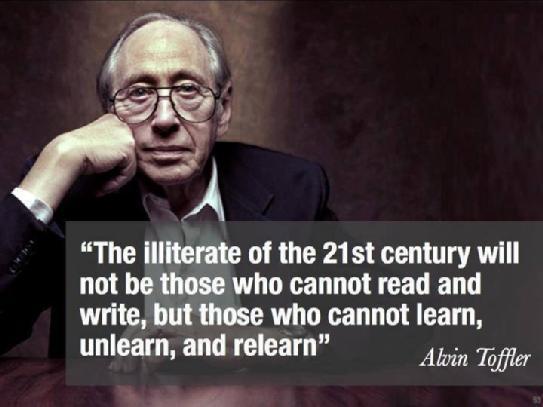
The illiterate of the 21st century will not be those who cannot read and write, but those who cannot learn, unlearn, and relearn.
Alvin Toffler
Although this quote is attributed to famous futurist Alvin Toffler, it seems impossible to discover when he said it -- if he said it -- prior to it appearing on his website. A web search for its source uncovers controversy, nothing conclusive. Some bloggers believe it to be a paraphrase of something he said in one of his books; others are less charitable and believe it should be attributed to another author altogether.
- 0 Comments
- May 14, 2014 12:00:00 PM
- Posted by Elad Inbar
- Topics: EdTech, STEM, Education, 21st Century Classroom
Improving gender and ethnic diversity in STEM jobs
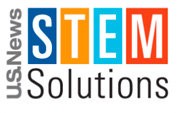 As everyone in the field is well aware, women and ethnic minorities are not sufficiently represented in STEM careers and in learning programs nationwide. Increasing their participation in a field that is fast becoming an important job provider in this country was the subject of a recent “Creating a Sustainable Commitment to STEM” session at U.S. News & World Report's STEM Solutions Conference in Washington, D.C.
As everyone in the field is well aware, women and ethnic minorities are not sufficiently represented in STEM careers and in learning programs nationwide. Increasing their participation in a field that is fast becoming an important job provider in this country was the subject of a recent “Creating a Sustainable Commitment to STEM” session at U.S. News & World Report's STEM Solutions Conference in Washington, D.C.
- 0 Comments
- May 13, 2014 4:00:00 PM
- Posted by Mike Nardine
- Topics: EdTech, STEM, National News, Education, Education Politics, Student Engagement
Relevant Posts
Popular Posts
Subscribe to Email Updates
-
I Want To Learn MoreADDITIONAL INFORMATION


